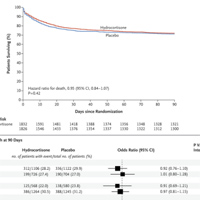Tag: septic shock

Sepsis-3, a New Definition. Solutions or New Problems?
Before we can discuss the "Sepsis-3" definitions, we need to look back at the history of Sepsis definitions, and what the rationale was leading the authors to create a new definition. Below is a brief, albeit non-exhaustive,... read more

Unexplained Mortality Differences Between Septic Shock Trials
Although the definition of septic shock has been standardized, some variation in mortality rates among clinical trials is expected. Insights into the sources of heterogeneity may influence the design and interpretation of... read more

On Diagnosing Sepsis
Two years ago, a panel appointed by the Society of Critical Care Medicine and the European Society of Intensive Care Medicine, referred to as a consensus conference, proposed a new definition for sepsis and new diagnostic... read more

R.E.B.E.L. EM – Fluid Responsiveness and the Six Guiding Principles of Fluid Resuscitation
Fluid resuscitation is a crucial aspect of emergency and critical care. Since the advent of the concept of early goal-directed therapy, we have placed a huge emphasis on aggressive fluid resuscitation in patients with severe... read more

Polymyxin B‑immobilised Hemoperfusion and Mortality in Critically Ill Patients with Sepsis/Septic Shock
Sepsis and septic shock originate from a dysregulated immune response to pathogens and cause millions of deaths worldwide. Endotoxin, a principal component of the outer membrane of Gram-negative bacteria, is a potent trigger... read more

Pharmacokinetics of meropenem in septic patients on sustained low-efficiency dialysis
The aim of the study was to describe the population pharmacokinetics (PK) of meropenem in critically ill patients receiving sustained low-efficiency dialysis (SLED). We found a relevant PK variability for meropenem in patients... read more

Predictors, Prevalence, and Outcomes of Early Crystalloid Responsiveness Among Initially Hypotensive Patients With Sepsis and Septic Shock
Two in three hypotensive sepsis patients were responsive to initial fluid resuscitation. Heart failure, hypothermia, immunocompromise, hyperlactemia, and coagulopathy were associated with the refractory phenotype. Fluid resuscitation... read more

Managing Sepsis and Septic Shock Current Guidelines and Definitions
While sepsis defies simple definition, it's generally understood to be a clinical syndrome caused by infection that may have profound adverse physiologic consequences. Although its precise incidence is unknown, sepsis is... read more

The ADRENAL Trial: Steroids in Septic Shock
Randomized clinical trials evaluating the efficacy of adjunctive corticosteroids in septic shock have shown conflicting evidence of clinical relevance. Two trials in particular looked at lower dose hydrocortisone (200mg/day)... read more

Importance of Second Antibiotic Doses in ED Sepsis Patients
Most studies evaluating early antibiotic administration in sepsis patients focus on timing of the first dose. We highlight many of these studies in our recent review article on Appropriate Antibiotic Therapy in Emergency... read more

Pooled analysis of higher versus lower blood pressure targets for vasopressor therapy septic and vasodilatory shock
Targeting higher blood pressure targets may increase mortality in patients who have been treated with vasopressors for more than 6 h. Lower blood pressure targets were not associated with patient‑important adverse events... read more

Adjunctive Glucocorticoid Therapy in Patients with Septic Shock
Among patients with septic shock undergoing mechanical ventilation, a continuous infusion of hydrocortisone did not result in lower 90-day mortality than placebo. We randomly assigned patients with septic shock who were undergoing... read more

Should We Manage All Septic Patients Based on a Single Definition?
It is indisputable from the biological and clinical perspectives that not all cases of sepsis are the same. On the contrary, most have great many differences, that is, different portals of entry, clinical manifestations,... read more

Hypothermia in Sepsis – The CASS Trial
Sepsis and especially septic shock (no matter what definition you use) is a recipe for multi-organ dysfunction and poor prognosis. In the past few years, we saw a lot of failed attempts trying to find something that could... read more




